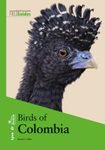Field / Identification Guide
By: Carrol L Henderson(Author), Steve Adams(Author), Alexander F Skutch(Foreword By)
387 pages, Col photos, dist maps
![Birds of Costa Rica Birds of Costa Rica]()
Click to have a closer look
About this book
Customer reviews
Related titles
About this book
At the biological crossroads of the Americas, Costa Rica hosts an astonishing array of plants and animals - over half a million species! Ecotourists, birders, and biologists come from around the world, drawn by the likelihood of seeing more than three or four hundred species of birds and other animals during even a short stay. To help all of these visitors, as well as local residents, identify and enjoy the wildlife of Costa Rica, Carrol Henderson published Field Guide to the Wildlife of Costa Rica in 2002, and it became the instant and indispensable guide.
Now Henderson has created a dedicated field guide to the birds that travelers are most likely to see, as well as to the unique or endemic species that are of high interest to birders. Birds of Costa Rica covers 310 birds - an increase of 124 species from the earlier volume - with fascinating accounts of the birds' natural history, identification, and behavior gleaned from Henderson's forty years of traveling and birding in Costa Rica. All of the accounts include beautiful photographs of the birds, most of which were taken in the wild by Henderson. There are new updated distribution maps and a detailed appendix that identifies many of the country's best bird-watching locations and lodges, including contact information for trip planning purposes.
Customer Reviews
Field / Identification Guide
By: Carrol L Henderson(Author), Steve Adams(Author), Alexander F Skutch(Foreword By)
387 pages, Col photos, dist maps
Customer Reviews:
Birds of Costa Rica - A Field Guide
by Keith Betton in UK
The origin of this book lies in part of a two volume work on the wildlife of Costa Rica, written by the author in 2002. In this book he deals with 308 of the species most frequently encountered by visiting birders.
To me the phrase "field guide" suggests that all potential species are included in a publication, so it is important that you realise that this book is just a taster, and you'll still need to carry Birds of Costa Rica by Richard Garrigues and Robert Dean (published by Helm).
So is there any value in having a book that includes photographs of only a third of the species on the Costa Rica checklist? In this case I think the answer is "yes" given the fact that most of the selected shots are of good quality. The text covers identification, habits and other tips mixed in together, backed up by short notes on status, measurements, geographical range and elevation. Carrol Henderson has taken a really unusual approach to creating the distribution maps. Rather than follow the norm and simply show the understood range for each species, he has only plotted the sites where he has personally seen them. While I can see the good intention behind this approach, it makes it appear as if each species is completely restricted to those sites. Perhaps a better approach might have been to show the understood range in grey and superimpose the sightings on top. Another interesting statistic is where he has assessed 23 of his own personal tours and shown how many times each species was seen. These might have made better sense as percentages, but it gives you an approximate indication of your chances of seeing each bird.
There are several appendices listing conservation organisations, research stations, birding groups and other information sources. There is an extensive listing of birding sites that are referred to in the distribution maps.
This is a well-produced book with good photos, but it will not take away the need to carry a proper field guide.





































